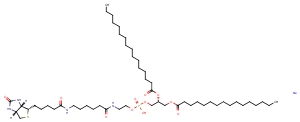1,2-Dipalmitoyl-sn-glycero-3-PE-N-(cap biotin) (sodium salt)
| Code | Size | Price |
|---|
| TAR-T36451-5mg | 5mg | £222.00 | |||||||||||||||||||||||||||||||||||||||||||||||||||||||||||||||||||||||||||||||||||||||||||||||||
| Special offer! Add £1 to your order to get a TargetMol CCK-8 Kit. Read more here. | |||||||||||||||||||||||||||||||||||||||||||||||||||||||||||||||||||||||||||||||||||||||||||||||||||
Quantity:
| TAR-T36451-10mg | 10mg | £348.00 | |||||||||||||||||||||||||||||||||||||||||||||||||||||||||||||||||||||||||||||||||||||||||||||||||
| Special offer! Add £1 to your order to get a TargetMol CCK-8 Kit. Read more here. | |||||||||||||||||||||||||||||||||||||||||||||||||||||||||||||||||||||||||||||||||||||||||||||||||||
Quantity:
| TAR-T36451-25mg | 25mg | £631.00 | |||||||||||||||||||||||||||||||||||||||||||||||||||||||||||||||||||||||||||||||||||||||||||||||||
| Special offer! Add £1 to your order to get a TargetMol CCK-8 Kit. Read more here. | |||||||||||||||||||||||||||||||||||||||||||||||||||||||||||||||||||||||||||||||||||||||||||||||||||
Quantity:
Prices exclude any Taxes / VAT
Overview
Regulatory Status: RUO
Shipping:
cool pack
Storage:
-20℃
Images
Documents
Further Information
Bioactivity:
1,2-Dipalmitoyl-sn-glycero-3-PE-N-(cap biotin) is a biotinylated phospholipid. It has been used in PEGylated polyamidoamine-dendrimer-conjugated supported lipid bilayers (SLB) to isolate circulating tumor cells and tumor cell microembolis from patient-derived blood by antibody-coated microfluidics. [1] It has also been used as a component of SLBs to detect protein-ligand binding with ortho-conjugated Texas Red DHPE. [2] In addition, 1,2-dipalmitoyl-sn-glycero-3-PE-N-(cap biotin) has been used in SLBs partitioned into nanowells to create DNA curtains, which can be used as a high-throughput tool for detection of protein-DNA interactions at the single molecule level.[3]
CAS:
384835-52-3
Formula:
C53H98N4NaO11PS
Molecular Weight:
1053.41
Purity:
0.98
SMILES:
[Na+].CCCCCCCCCCCCCCCC(=O)OCC(COP([O-])(=O)OCCNC(=O)CCCCCNC(=O)CCCCC1SCC2NC(=O)NC12)OC(=O)CCCCCCCCCCCCCCC
References
Visnapuu, M.-L., Fazio, T., Wind, S., et al. Parallel arrays of geometric nanowells for assembling curtains of DNA with controlled lateral dispersion. Langmuir 24(19), 11293-11299 (2008).
Jung, H., Robison, A.D., and Cremer, P.S. Detecting protein-ligand binding on supported bilayers by local pH modulation. J. Am. Chem. Soc. 131(3), 1006-1014 (2009).
Yeh, P.-Y., Chen, Y.-R., Wang, C.-F., et al. Promoting multivalent antibody-antigen interactions by tethering antibody molecules on a PEGylated dendrimer-supported lipid bilayer. Biomolecules 19(2), 426-437 (2018).



